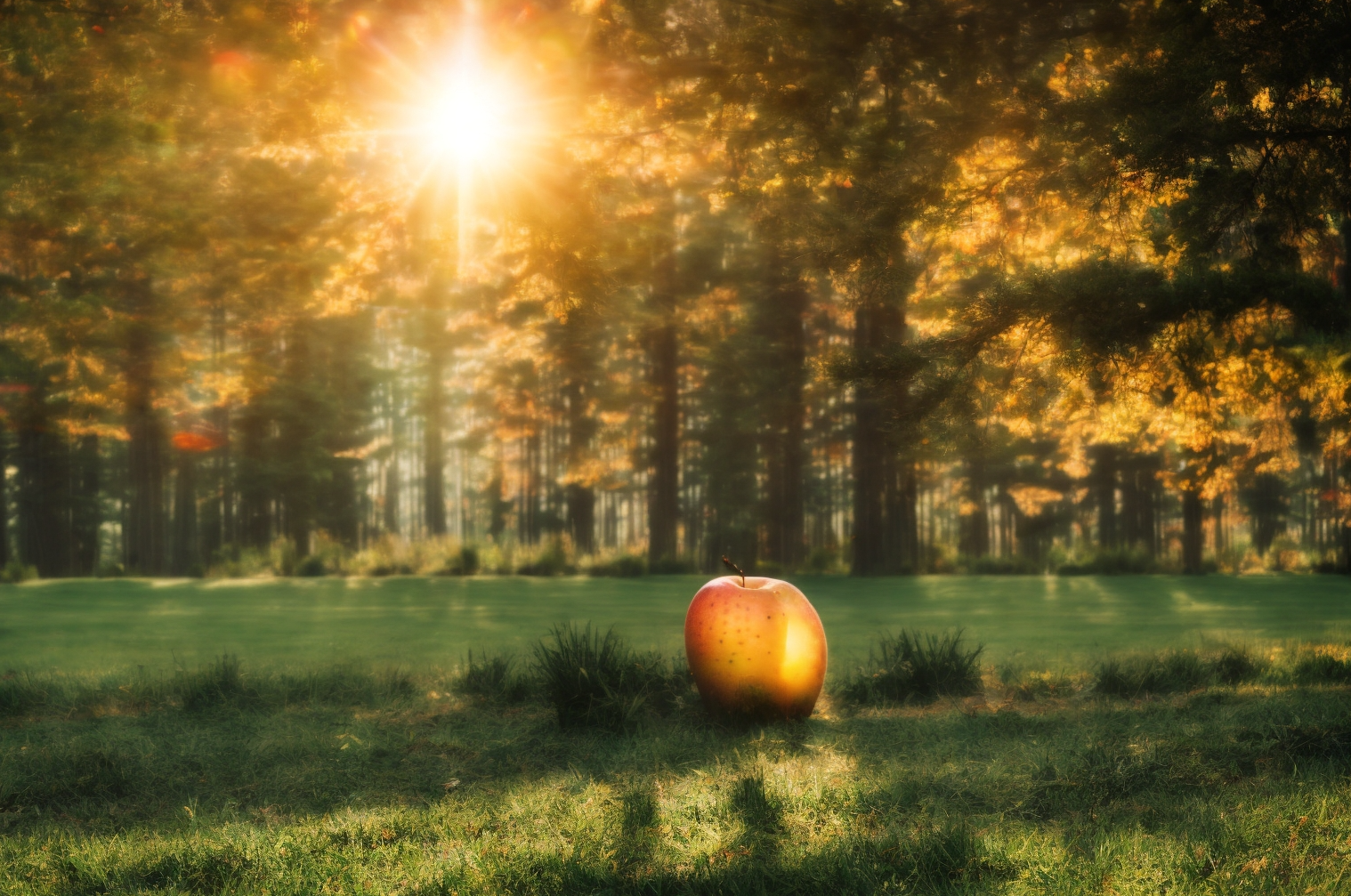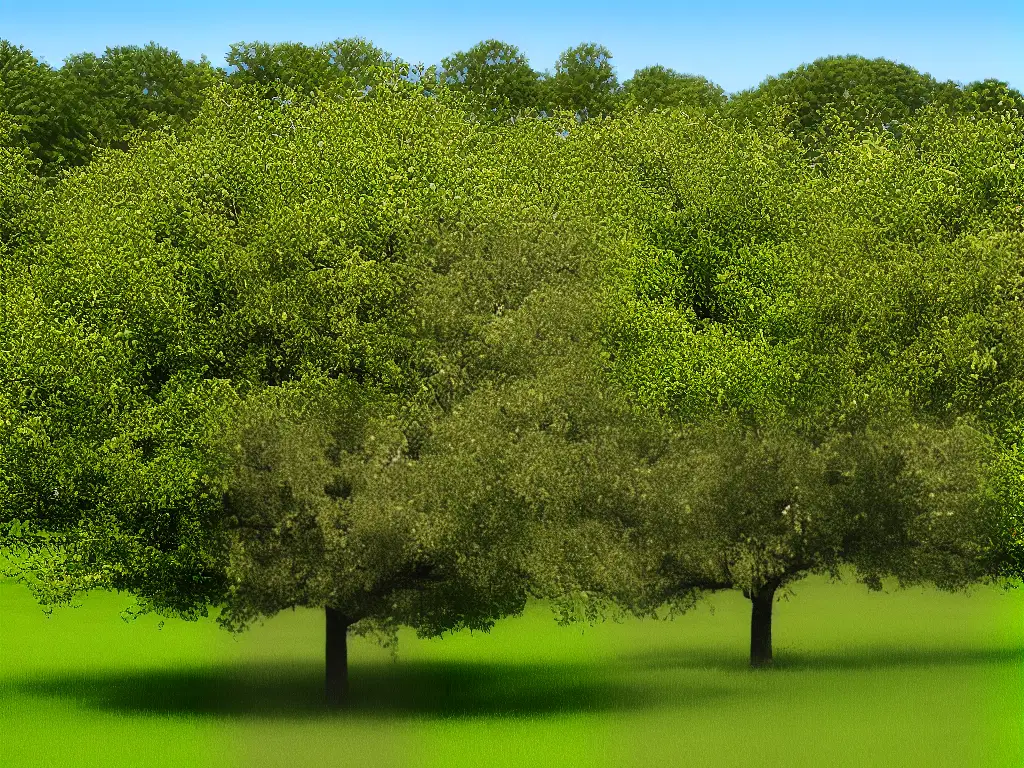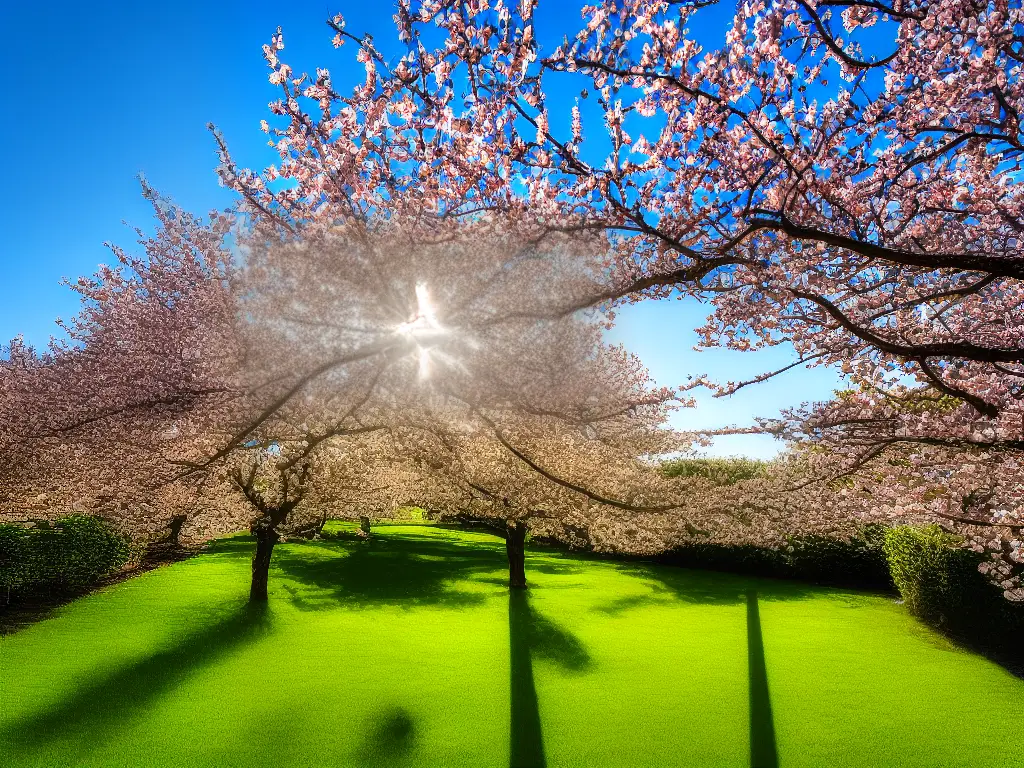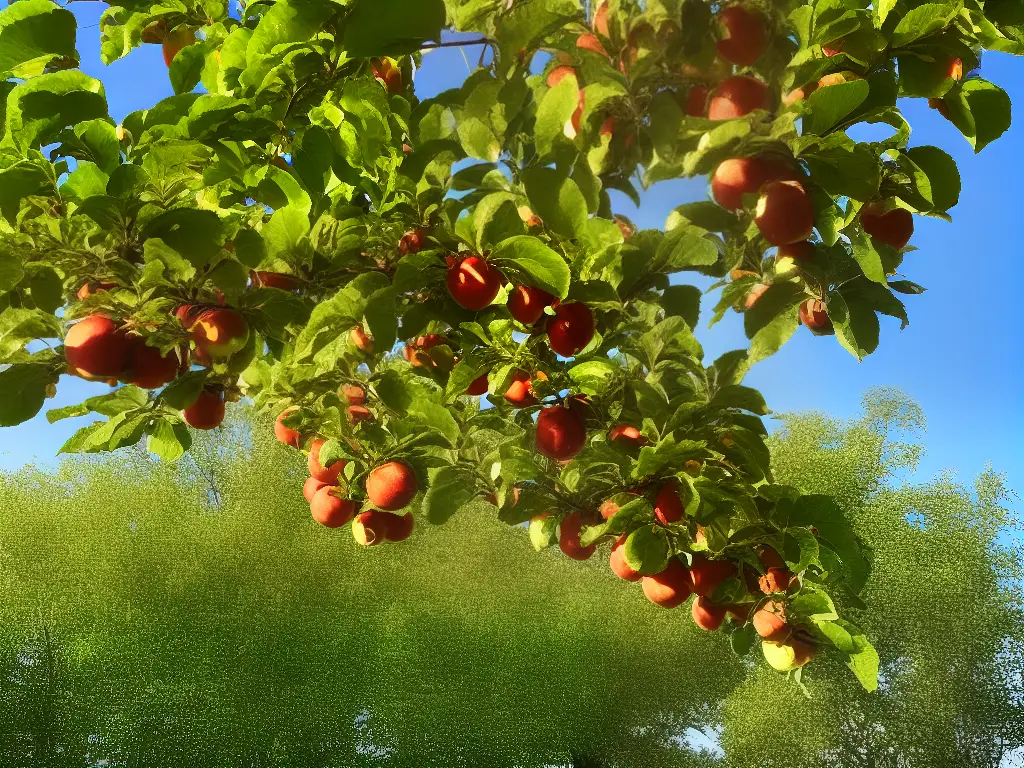 Apple trees are cherished for their delicious fruit and the beauty they bring to our gardens and orchards. To ensure a bountiful harvest and a healthy tree, it is crucial to understand the sunlight requirements and choose the best variety, location, and planting techniques for your specific situation. This guide will teach you everything you need to know about providing optimal sunlight exposure for your apple trees, as well as common issues to watch out for and how to apply this knowledge in real-life scenarios.
Apple trees are cherished for their delicious fruit and the beauty they bring to our gardens and orchards. To ensure a bountiful harvest and a healthy tree, it is crucial to understand the sunlight requirements and choose the best variety, location, and planting techniques for your specific situation. This guide will teach you everything you need to know about providing optimal sunlight exposure for your apple trees, as well as common issues to watch out for and how to apply this knowledge in real-life scenarios.
Understanding Sunlight Requirements
Apple trees thrive in sunlight and require specific amounts of light to optimize their growth and fruit production. Understanding the sunlight requirements for apple trees and knowing how to provide the best sunlight exposure are essential for a successful harvest. This guide will help you grasp the differences between full sun, partial sun, and shade, as well as how each affects your apple tree’s health and productivity.
1. Know the basic sunlight requirements
Apple trees typically require 6-8 hours of direct sunlight each day, which is considered full sun exposure. This amount of sunlight is crucial to ensure the tree receives enough energy for photosynthesis, growth, and fruit development. It is essential to choose a planting location that offers this daily dose of full sun for the best results.
2. Understand the differences between full sun, partial sun, and shade
- Full sun: Full sun means that the tree gets the required 6-8 hours of direct sunlight every day. This guarantees enough energy for the tree to produce a healthy amount of fruit. Full sun is the ideal sunlight condition for most apple trees.
- Partial sun: Partial sun means that the plant gets direct sunlight for 4-6 hours daily, with dappled or filtered sunlight for the remaining daylight hours. While apple trees can still grow in these conditions, their fruit production will likely be reduced.
- Shade: Shade signifies that the tree receives less than 4 hours of direct sunlight each day, which is not ideal for apple trees. Trees growing in these conditions can struggle to produce fruit and could experience stunted growth.
3. Choose the right apple tree varieties
Some apple tree varieties are more tolerant of partial sun than others. If you are limited to a location with less-than-ideal sunlight exposure, consider planting varieties that can still flourish in those conditions. Examples of apple tree varieties that tolerate partial sun include ‘Liberty,’ ‘Honeycrisp,’ and ‘Spartan’. Consult with your local nursery or extension office for suggestions tailored to your specific location.
4. Monitor the sunlight exposure
It is vital to continually monitor the amount of sunlight your apple tree receives throughout the year. Changes in the surrounding environment, such as the growth of nearby trees or new building constructions, can affect the amount of sunlight exposure your apple tree gets. Prune surrounding trees and shrubs as needed to maintain sufficient sunlight for your apple tree’s growth and fruit production.
5. Utilize reflective surfaces
If your apple tree is planted in a location with less-than-ideal sunlight, you might be able to enhance the amount of light the tree receives by using reflective surfaces. Objects such as white fences, rocks, or walls can reflect sunlight onto the tree, improving its exposure. However, this should not be the primary solution, as direct sunlight is always the best source for optimum growth.

Apple Tree Varieties
Apple trees are a popular choice for hobbyists and enthusiasts looking to grow fruit in their backyard. Selecting the best apple tree variety according to your location and desired fruit characteristics is crucial for successful growth and fruit production. One essential factor to consider when planting apple trees is their sunlight requirements. This guide will provide information on different apple tree varieties and their sunlight needs for optimal growth and fruit production.
1. Golden Delicious:
This apple variety is known for its sweet, versatile flavor, and it can adapt to various climates. It requires at least 6 hours of direct sunlight daily. Ensure that your planting location receives adequate sunlight, as the Golden Delicious apple tree needs plenty of light for proper fruit development and high-quality flavor.
2. Granny Smith:
Granny Smith is a tart and crisp green apple widely used for making pies and sauces. It thrives in full sun, so plant these trees where they can receive 6 to 8 hours of direct sunlight daily. Exposing your Granny Smith apple tree to a sufficient amount of light is crucial for the formation of sugars, which contribute to its distinct flavor.
3. Fuji:
Known for its sweet and crisp taste, the Fuji apple tree is ideal for growing in warmer climates. It needs a minimum of 6 hours of direct sunlight every day to grow and produce a good yield. Inadequate sunlight can lead to poor fruit production and quality.
4. Honeycrisp:
Honeycrisp is a delicious and popular apple with a unique balance of sweetness and tartness. It thrives in colder climates, where it gets at least 6 to 8 hours of direct sunlight daily. Providing the Honeycrisp apple tree with enough sunlight will result in better fruit quality and help the tree withstand cold temperatures.
5. Gala:
The Gala apple is known for its mild, sweet flavor and is perfect for snacking and fresh eating. This apple variety needs full sun exposure, which means 6 to 8 hours of direct sunlight daily, for efficient photosynthesis and fruit production.
6. McIntosh:
The McIntosh apple is a classic variety with a distinctive sweet and tart taste. It favors cooler climates and requires a minimum of 6 hours of direct sunlight daily for optimal growth and fruit production. Ensure your tree is in a spot where it gets sufficient sunlight to produce high-quality fruit.
7. Red Delicious:
Red Delicious apples are known for their striking appearance and sweet taste. These trees require at least 6 to 8 hours of direct sunlight daily to maximize sugar content and overall fruit quality. Avoid planting Red Delicious apple trees in a location with limited sunlight, as this may reduce fruit quality and yield.
When choosing an apple tree variety for your backyard, keep in mind that sunlight requirements vary among the different types. Plant your apple tree where it will receive full sun exposure, generally within the range of 6 to 8 hours of direct sunlight daily. Meeting the sunlight needs of your chosen apple tree variety will increase the chances of a successful harvest, contributing to a delicious and bountiful fruit yield. Happy planting!

Pruning for Sunlight Exposure
Pruning apple trees is an important aspect of maintaining tree health and promoting fruit production. Adequate sunlight exposure is crucial for the growth and development of the apple tree, and proper pruning helps ensure that all branches receive the necessary sunlight. This guide will walk you through the steps and best practices for pruning your apple tree to maximize sunlight exposure and fruit production.
1. Understand the Importance of Pruning:
- Improved fruit production: Proper pruning improves the tree’s overall fruit production by allowing sunlight to reach all the branches, maximizing photosynthesis and growth.
- Better tree health: Removing dead or diseased branches during pruning reduces the risk of disease and pests spreading throughout the tree.
- Tree formation and structure: Pruning helps maintain the tree’s desired shape and structure, allowing for more efficient fruit production and preventing branches from becoming overcrowded.
2. Gather the necessary tools:
- Pruning shears: Ideal for cutting small branches up to 1 inch in diameter.
- Loppers: Suitable for cutting branches between 1-2 inches in diameter.
- Pruning saw: Used for cutting larger branches over 2 inches in diameter.
- Gloves and safety goggles: To protect your hands and eyes during the pruning process.
3. The best time for pruning:
- Late winter or early spring is the ideal time to prune apple trees when the tree is still dormant, and the risk of disease transmission is lower.
4. Pruning techniques for sunlight exposure:
- Remove dead or diseased branches: This will help prevent the spread of disease and pests while also improving the overall health of the tree.
- Thin out crowded branches: Cut back branches that are growing too close together to allow adequate sunlight and air circulation.
- Encourage horizontal growth: Apple trees produce more fruit on horizontal branches, so focus on keeping the main scaffold branches horizontal and well spaced.
- Remove water sprouts and suckers: Water sprouts are vertical shoots that grow from the tree’s main branches and can block sunlight from reaching the lower branches. Suckers are shoots that grow near the base of the tree and divert essential nutrients away from the main branches.
- Establish a central leader: Choose a strong upright branch as the central leader and remove any competing branches to ensure the tree maintains its desired shape and structure.
5. Post-pruning care:
- Watering: Make sure your tree receives adequate water after pruning, especially during dry periods.
- Fertilizing: Apply a balanced fertilizer to your apple tree to promote healthy growth and fruit production.
- Pest and disease prevention: Monitor your tree for signs of pests and disease and treat accordingly to maintain overall tree health.
Pruning apple trees for sunlight exposure is an essential practice to ensure maximum fruit production and tree health. By following the steps and guidelines outlined above, you will be well on your way to growing a thriving, productive apple tree. Remember to practice proper pruning techniques, and soon you will be enjoying the fruits of your labor.

Common Issues and Solutions
Proper sunlight exposure is essential for the healthy growth and fruit production of apple trees. However, too much sunlight or improper positioning can lead to problems such as sunburn, uneven fruit ripening, and disease. In this guide, we will explore these common issues and offer solutions to ensure the optimal growth and productivity of your apple trees.
Sunburn
Sunburn is a common issue that occurs when apple trees receive too much direct sunlight, causing the fruit and foliage to burn. This can lead to lower fruit quality and reduced yields.
To minimize sunburn, it’s essential to:
- Choose a planting location with proper sun exposure (6-8 hours of direct sunlight per day) but shielded from the harsh afternoon sun. This can be achieved by planting your apple trees on the north or east side of your property.
- Properly water your apple trees, as dry conditions increase the risk of sunburn.
- Use shading materials, such as shade cloth or tree netting, for young or newly planted trees to protect them from extreme sunlight.
- Regularly prune the trees to improve air circulation and ensure balanced growth.
Uneven Fruit Ripening
Uneven fruit ripening can occur when portions of the apple tree receive more sunlight than others, leading to inconsistencies in fruit maturation and quality.
To prevent uneven fruit ripening, it’s important to:
- Plant your apple trees in a location with an even distribution of sunlight, without any shadows caused by buildings or other vegetation.
- Regularly prune your apple trees to maintain an open canopy structure, allowing for an even distribution of sunlight to penetrate and reach all parts of the tree.
- Thin out fruit clusters to promote a more even ripening process and better fruit quality.
Disease
Improper sunlight exposure can exacerbate several apple tree diseases, such as powdery mildew and fire blight, due to excessive humidity and damp conditions created by lack of sunlight and improper air circulation.
To minimize the risk of disease, it’s crucial to:
- Plant apple trees in a location with good sun exposure to ensure that the foliage dries quickly after rainfall or morning dew, reducing disease susceptibility.
- Properly space and prune apple trees to promote good air circulation and minimize humidity, making it harder for diseases to establish and spread.
- Monitor your apple trees regularly for early signs of disease and address them immediately through proper treatments and care practices.
Ensuring optimal sunlight exposure for your apple trees is crucial for their health and productivity. By addressing common issues such as sunburn, uneven fruit ripening, and disease, you’ll be able to cultivate healthy, thriving apple trees and enjoy an abundance of delicious fruits.

By taking the time to understand and implement the best sunlight exposure practices for your apple trees, you’re setting up a strong foundation for a thriving and fruitful tree. Every tree is different, and learning how to adapt and adjust to your tree’s specific needs will help you overcome common issues and ensure a healthy, productive harvest year after year. With your newfound knowledge, you’re ready to embark on a fruitful journey of apple tree cultivation and enjoy the fruits of your labor for many seasons to come.